Saturday, January 30, 2010
Tuna and Avocado cubes 鮪とアボカドの角切り
This is the dish shown on the front jacket cover of Mark's book. I meant to make this for some time but somehow I could not synchronize having tuna sashimi and ripe avocado at the same time. The taste and texture of avocado are quite a good match for tuna sashimi. The most significant and successful sushi invention in the U.S. must be California roll. California rolls use crab meat and avocado, which is also a good combination. We often have slices of avocado like sashimi along with other sashimi items served with soy sauce and wasabi. That is also good.
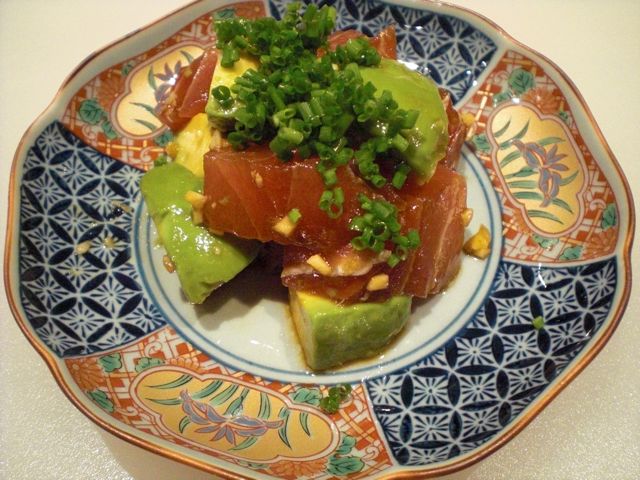
As long as you have the ingredients, making this dish is simple and quick. I followed the recipe in Mark's book in the back jacket flap verbatim. I cut avocado into 1/2 inch cubes and dressed with lemon juice to prevent discoloration. I then cut sashimi tuna into 1/2 inch cubes. The dressing is made of minced garlic (I used one fat clove), 2 tbs of soy sauce and 1 tsp each of sake and dark roasted sesame oil. I tossed the tuna and avocado cubes and served them with chopped chives. This is excellent! Quite different from the usual tuna sashimi. The dressing is rather assertive but surprisingly good. The above is a serving for one person and the amount is perfect. You do not want to eat too much of this dish. This dish definitely made it to the "teiban" 定番 list of our home Izakaya dishes.
Thursday, January 28, 2010
Rare tastes 珍味
A Japanese word "chinmi" 珍味 is often used to describe food items which are rare and/or limited to certain regions of Japan. You can assemble these rare tastes more easily nowadays by mail order and because of many special sales featuring these rare and regional food items (usually held in department stores in Japan). Even in the U.S., more and more of these "chinmi" items are becoming available, albeit much more limited compared to Japan. Tonight, we had an assortment of these rare tastes with sake.
Dried "Shishamo" fish 寒干しししゃも
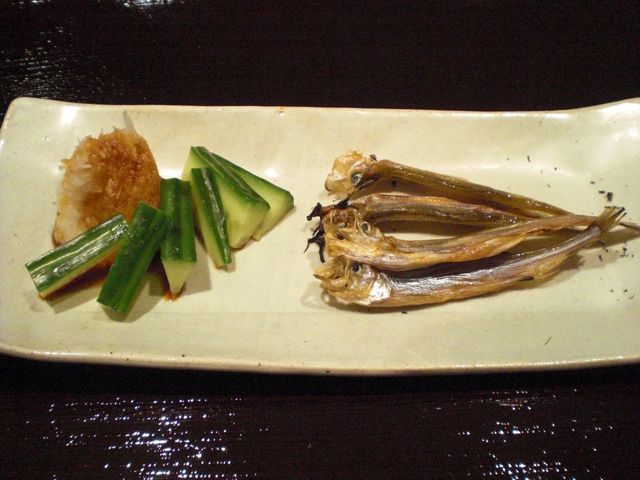
This small fish called "Shishamo" ししゃも or 柳葉魚、Spirinchus lanceolatus, is harvested only on the southern pacific coast of Hokkaido. I grew up with this fish and they are very popular drinking snack items especially in Hokkaido. These are usually semi-dried and we get them frozen in the United States. My mother sent these to us. They were (supposedly) "fully dried" in the cold northwind of Hokkaido. They can be eaten as is but I grilled them briefly over the gas fire and served them with grated daikon 大根おろし and soy sauce. They are a bit chewier than semi-dried (which has to be more thoroughly grilled) but they are very flavorful. To my surprise, even my wife liked them.
Raw Octopus marinated in wasabi sauce たこぶっかけ (lt)、Salmon roe with grated daikon いくら甘酢大根おろし (ctr)、Raw Squid mariated in hot red peper sauce イカぶっかけ (rt)
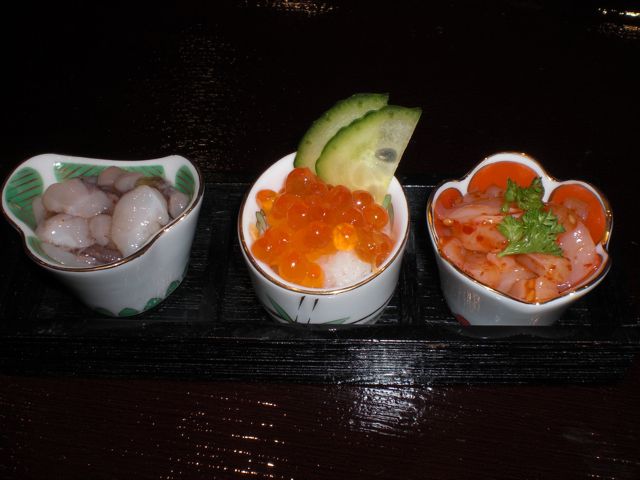
My wife and I love "squid and guts" or squid "shiokara" いかの塩辛. This is definitely an acquired taste but most people who love sake will love this as well because both go together so well. Shiokara is made from fresh squid which is salted and slightly fermented with squid innards (mostly liver). The homemade variety made with a light amount of salt (this kind does not last long) is the best. Many commercial ones are too salty but more recently, we can get a less salty kind in a small plastic pouch in the frozen case of the Japanses grocery store. Last time we were in Hakodate we had commercial but local "shiokara" which was excellent. Another similar preparation is called "okizuke" 沖漬け. "oki" in Japanese means "far-away from the shore". Supposedly, fishermen start marinading the freshly caught squid (sometimes other fish or shell fish) while in their boat and by the time they come back to shore (overnight or one day), the dish is done. Once in a blue moon, Chef Kudo at Tako Grill makes squid okizuke which is exquisite. Last time we were in Kanazawa, a small fluorescent squid called "hotaruika" 蛍イカ or firefly squid was in season. We really enjoyed "okizuke" of this small squid. Unfortunately, it is next to impossible to get a fresh squid suitable for making these dishes in the U.S. What we have here is the closest substitute.
In the above image, from left to right are raw octopus with wasabi sauce たこぶっかけ、salmon roe with grated daikon いくら大根おろし (grated diakon is seasoned with sweet vinegar which is only item I prepared)、and raw squid with hot sauce イカぶっかけ. These squid and octopus dishes are variations of "shiokara" and "okizuke" and are called "bukkake" ぶっかけ in which small pieces of raw octopus or squid are marinated in a spicy sauce. Here, the octopus is marinated in "wasabi" sauce and squid in red pepper sauce. Both come in a small plastic pouch and bought frozen. These are perfect accompaniment for sipping sake.
Cheese stuffed squid チーズいか
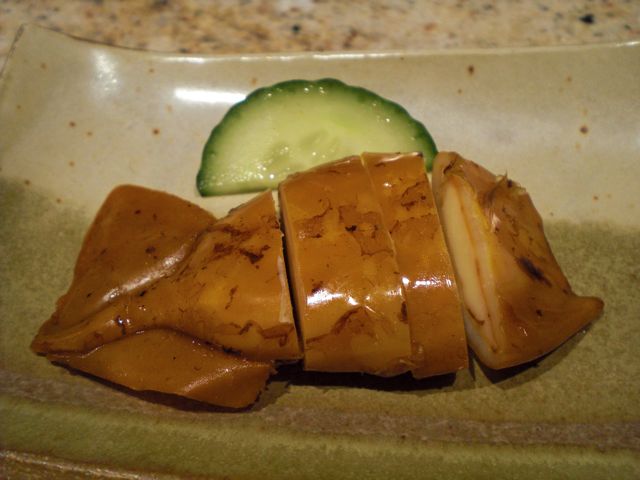
This is another item, my mother sent us. A Japanese word "Ikomi" 射込み means to "insert" or to "stuff" and this one is a type of "ikomi" squid. This is a commercial product in which a small squid was stuffed with cheese and cooked. This is eaten as is. Interesting combination of tastes. I served one for each of us but my wife went back and got another one. She must have liked it.
Smoked scallop 帆立ての薫製

This is a smoked whole scallop from Lake Saroma 佐呂間湖 in Hokkaido. To us, it is a bit too smoky and chewy.
Dried "Shishamo" fish 寒干しししゃも
This small fish called "Shishamo" ししゃも or 柳葉魚、Spirinchus lanceolatus, is harvested only on the southern pacific coast of Hokkaido. I grew up with this fish and they are very popular drinking snack items especially in Hokkaido. These are usually semi-dried and we get them frozen in the United States. My mother sent these to us. They were (supposedly) "fully dried" in the cold northwind of Hokkaido. They can be eaten as is but I grilled them briefly over the gas fire and served them with grated daikon 大根おろし and soy sauce. They are a bit chewier than semi-dried (which has to be more thoroughly grilled) but they are very flavorful. To my surprise, even my wife liked them.
Raw Octopus marinated in wasabi sauce たこぶっかけ (lt)、Salmon roe with grated daikon いくら甘酢大根おろし (ctr)、Raw Squid mariated in hot red peper sauce イカぶっかけ (rt)
In the above image, from left to right are raw octopus with wasabi sauce たこぶっかけ、salmon roe with grated daikon いくら大根おろし (grated diakon is seasoned with sweet vinegar which is only item I prepared)、and raw squid with hot sauce イカぶっかけ. These squid and octopus dishes are variations of "shiokara" and "okizuke" and are called "bukkake" ぶっかけ in which small pieces of raw octopus or squid are marinated in a spicy sauce. Here, the octopus is marinated in "wasabi" sauce and squid in red pepper sauce. Both come in a small plastic pouch and bought frozen. These are perfect accompaniment for sipping sake.
Cheese stuffed squid チーズいか
Smoked scallop 帆立ての薫製
Wednesday, January 27, 2010
Cornmeal Parmesan Chicken tender with crispy skin 鶏の笹身のパルメザンコーンミール焼きとカリカリ鶏皮
We love a crispy skin, either chicken, fish or pork. To make chicken skin very crispy, I parboil the chicken skin in water with salt and sake for 10 minutes until the fat was rendered. Then, I patted them dry and placed them (no oil needed) in a frying pan and put another identical frying pan on the top to press down. Cook it for 5-8 minutes on low heat and turn over and cook another 5 minutes until the skin is very crispy. You may still have to remove some excess fat from the pan using a paper towel during the cooking. Sprinkle on a bit of salt while it is hot.
For dipping sauce, I made a mixture of Dijon mustard and honey (about equal amount or less honey depending on your taste). Honey will melt easily and changes the consistency and color of the mustard. This one goes well with any drink.
Monday, January 25, 2010
Simmered "kiriboshi" daikon 切り干し大根の煮物
"Kiriboshi" daikon is an old fashioned preserved vegetable in which daikon is cut into thin, long strands and dried. I bought a package some time ago in the Japanese grocery store. Obviously I had forgotten about it but found it while I was going through my Japanese food items in the pantry. I decided to make some dishes using this. It is rather odd looking and it doesn't smell particularly pleasant (all cruciferous vegetables appear to have similar smell but drying makes it stronger). The drying, however, does add more sweetness. To use this, wash briefly in cold running water and rehydrate in enough water for 20-30 minutes.
Simmered "kiriboshi" daicon 切り干し大根の煮物

This is a very typical way of using "kiriboshi" daikon. After re-hydration, I squeeze water from it and set aside. I thinly slice carrot and julienne. I also julienne abura-age 油揚げ or deep dried tofu pouch. The amounts are totally arbitrary. You could also add shiitake mushroom (dried and re-hydrated shiitake is the best for this but I did not have enough time to re-hydrate dried shiitake this time). In a pan, I add a small amount of vegetable oil and a dash of dark roasted sesame oil and add few flakes of dried red pepper. I then sauté daikon and carrot. When the oil has coated the each vegetable pieces, add abura-age and enough "dashi" stock to cover (In my case, I used about 200ml). I place an "otoshi buta" and simmer for 10-15 minutes. "Otoshi buta" 落とし蓋 or "drop lid" is frequently called for in Japanese simmered "nimono" 煮物 recipes. It is a lid (often wood) that is smaller in diameter than that of the pan used. This way, the ingredients will cook evenly while allowing evaporation of the simmering broth. Instead, you could use a kitchen parchment paper cut slightly smaller than the opening of the pan (called "kami buta" or paper lid). You do not need a special wooden lid (I have one but it was too big for this pan). A plate or a regular metal lid smaller in diameter than the pan's opening will do as shown here.

After coming to a boil, simmer for 10-15 minutes. For seasoning, I add 3 tbs of mirin and 2-3 tbs of soy sauce (for 200ml of dashi). I add soy sauce in two increments, tasting each time, to adjust the seasoning. Addition of soy sauce just before completing cooking gives fresh soy sauce flavor as well. If you are having this dish with sake, I use less soy sauce and for rice condiments, I use more soy sauce. Simmer for another 10-15 minutes and cut the flame and let it cool in the broth. I garnished with snow peas blanched, shocked in cold water and then julienned.
"Kiriboshi" daikon and celery in vinegar dressing 切り干し大根のハリハリ
Simmered "kiriboshi" daicon 切り干し大根の煮物
After coming to a boil, simmer for 10-15 minutes. For seasoning, I add 3 tbs of mirin and 2-3 tbs of soy sauce (for 200ml of dashi). I add soy sauce in two increments, tasting each time, to adjust the seasoning. Addition of soy sauce just before completing cooking gives fresh soy sauce flavor as well. If you are having this dish with sake, I use less soy sauce and for rice condiments, I use more soy sauce. Simmer for another 10-15 minutes and cut the flame and let it cool in the broth. I garnished with snow peas blanched, shocked in cold water and then julienned.
"Kiriboshi" daikon and celery in vinegar dressing 切り干し大根のハリハリ
This is another classic way of using this ingredients. "Harihari" is a Japanese word to indicate "crunchy". Beside dried daikon, this dish usually calls for julienned cucumber. While I was making this, all the mini-cucumbers I had (although I bought them just few days ago) had brownish discoloration around the seeds and did not taste right (This appears not to be the usual brand I get. It said "seed-less" but it definitely had seeds). So after cutting all 5 cucumbers, I had to discard all of them. Without cucumbers, I rummaged in the refrigerator and found celery.
After re-hydration, I squeezed out the excess water and put the "kiriboshi daikon" in the bowl. I sliced a celery stalk diagonally and thinly. I mixed a small amount of Chinese red pepper paste "Toubanjan" 豆板醤 (1/5 tsp), sushi vinegar (3 parts) and mirin (1 part) and dressed.
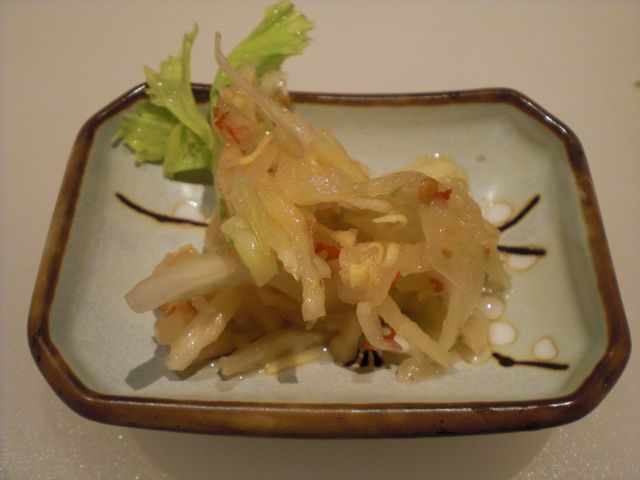
After re-hydration, I squeezed out the excess water and put the "kiriboshi daikon" in the bowl. I sliced a celery stalk diagonally and thinly. I mixed a small amount of Chinese red pepper paste "Toubanjan" 豆板醤 (1/5 tsp), sushi vinegar (3 parts) and mirin (1 part) and dressed.
The kiribishi daikon definitely has a crunch as name "harihari" indicates. It is a very simple (especially if you have a cucumber) and refreshing dish. Even with substituting with celery, it was not so bad.
Saturday, January 23, 2010
Fried Oyster カキのフライ
Fried oyster is by no means a traditional Japanese dish but Japanese appear to like it very much. This item appears on Izakaya menus as well as family style Japanese restaurants called "taishu shokudo" 大衆食堂 or similar low-key restaurants. the Japanese modification must be the use of Japanese "panko" パン粉 for breading. Thinly cut raw cabbage キャベツ is served as an accompaniment as well as "tonkatsu" sauce (often).
Classically, this is perfect with cold beer but we do not drink beer anymore so we had this with cold sake.
Thursday, January 21, 2010
Ramen noodle ラーメン
I just made this ramen noodles out of whatever was in our refrigerator and dried ramen noodles that I had (I already mentioned that I like frozen "raw" noodles from the Nishiyama seimen the best). This is not the usual way I make Ramen especially since I often make "Yakibuta" 焼豚 or Sino-Japanese pot roast of pork, separately and ahead of time. I use "Yakibuta" slices as a topping for the Ramen noodle as is often done. But I had only uncooked pork and this is how I made it this time.
I used one serving of dried noodles for two small servings. I had the trimmings of a pork tenderloin which I just sliced very thinly (whatever amount). I also used onion (1 small), "nappa" Chinese cabbage (2 leaves), fresh shiitake mushroom (3-4 small), baby spinach (1 small handful), and thinly sliced scallion for garnish (2, white part only). You could use any vegetables and proteins you may have. I minced ginger (1/4 tsp) and garlic (1 clove) and sautéed in a sauce pan in a small amount of vegetable oil (2 tsp) and a dash of roasted sesame oil for 30 seconds. I added the pork slices until the color turns white. Before garlic burns, I added mirin (1 tbs) and soy sauce (1 tbs) and braise until the meat is cooked and liquid is almost all gone. Remove the meat from the pan and set aside. In the same pan, I add vegetable oil (2 tsp) and sauteed sliced onion and thinly cut white bottom part of the nappa cabbage. Brown bits or "fond" will accumulate on the bottom and the side of the pan because of the sugar in the mirin and in the onion. After the vegetables wilt, I de-glaze with Chicken broth (I used low-fat, low-sodium Swanson chiken broth in a box), add more both (about 200ml) and 100ml of water (amount of the water depends on the saltiness of broth). I then add sliced shiitake and green part soft parts of nappa cabbage and simmer for few minutes. I add spinach which will wilt in 30 seconds. There should be enough saltiness but taste and adjust by adding soy sauce. Meanwhile I cook the noodle for 3-4 minutes to desired doneness, drain and place it in the bowls. Pour the broth in the bowls leaving the vegetables in the pan. Then I arrange the pork, vegetables, and garnish with scallion and cracked pepper. The color of broth is mostly coming from de-glazing. This is a rather healthy version of Ramen but it is not bad for a quick dish.
We usually do not like to use "seasoning packets" that come with gourmet instant ramen noodles, since it often contains a large amount of animal fat as well as salt. Fortunately you could just buy noodles either dry (not pre-deep fried) or raw "frozen".
Tuesday, January 19, 2010
Cucumber salad with smoked scallop and poached chicken breast with black vinegar sauce きゅうり、貝柱、鶏肉のサラダの黒酢ソース和え
This is another small dish you make from whatever you have at hand. Since at our Home Izakaya, I usually make one dish, eat that dish with some sake and then make another, sometimes, making a small dish quickly from nothing is very necessary. In any case, this night, I found leftover poached chicken breast in black vinegar sauce, fresh American mini-cucumber and the New Year care package we just received from my mother which included semi-dried lightly smoked Hokkaido scallops 貝柱の薫油漬. Of course, you could omit the scallops or substitute with finely chopped smoked ham or salami.
For two small servings, thinly slice one mini-cucumber and salt lightly, mixing well or "knead" lightly and let it stand for 5 minutes on the cutting board. Then, squeeze out excess moisture. I also skinned and cut 2 Campari tomatoes into quarters. I crumbled one semi-dry scallop into small pieces and mixed the pieces into the cucumber and tomatoes then dressed with sushi vinegar. I sliced the chicken breast paper thin, placed the slices on top of the cucumbers and drizzled the black vinegar sauce over everything.
It is interesting that the black vinegar sauce congealed to a thicker gelatinous consistency since it contains protein/collagen from the chicken skin. When I was growing up in Sapporo, even inside our old house, it got very cold in winter especially at night without any source of heat. When my mother made a simmered fish dish in soy sauce flavored broth or "nizakana" 煮魚 and the leftover was kept in a kitchen cabinet, the sauce congealed in the bottom of the plate into jello next morning. This is called "nikogori" 煮凝り. It is a natural equivalent of making a fashionable "gelée" sauce by adding gelatin into a sauce. In any case, as a child, I really liked this "nikogori" on hot rice (it melted quickly). The reduced black vinegar sauce indeed attained a similar consistency (in the refrigerator not in the room, though). This dish is definitely best with sake, since it has a vinegary taste.
Monday, January 18, 2010
Potato salad with cod roe, black olive and Cornichons タラモサラダ
Potato salad is not really Japanese or Izakaya food, yet, it is definitely very common home cooked food in Japan. Last time we were in one of our favarite Izakayas in Kyoto, "Akagakiya" 赤垣屋, the first appetizer or "Otoshi" おとうし was potato salad which was excellent. There is always something different from usual American-style potato salad in Japanese versions. Mark's book has a rather sophisticated version of potato salad (p81). One of more common Japanese variations is called "taramo" which is a made-up word from "tara-ko" (cod roe) and "imo" (potato). I made my variation of "taramo" salad since I had "tarako" I did not use after making other dishes. I added black olive, finely sliced French Cornichons (tiny cucumbers, gherkins, pickled in a tangy marinade), and instead of using just mayonnaise, I used an equal mixture of plain yogurt and mayonnaise, which is bit better fat-wise and also add a slighly sour tangy flavor to the dish. An addition of yogurt, however, makes the salad a bit watery, so it is important to use white potatoes and cook them whole and remove the skin before mashing to make sure the potato is rather dry to begin with.
I used two large white potatoes which were boiled in salted water whole (you could microwave, also) until a skewer goes through easily. Remove skin using a towel and mash with 1 tbs of butter and a pinch of salt (be light on salt since "tarako" is also salty) and let it cool to a room temperature. Meanwhile I remove the pits from 7-8 black oil cured olives (I am not sure which kind we got here from a local gourmet grocery store) and coarsely chop. I usually use thinly sliced fresh cucumbers (salted and then vinegared) but the mini-cucumbers we got this time did not taste particularly good, so I used pickled French Cornichons finely sliced (4-5). Add 2 tbs each of mayonnaise and plain yogurt and one large sac of tarako (which was removed from the sac and mixed with 1 tsp of lemon juice and 1/2 tsp of sake). Taste and adjust the seasoning (salt and pepper). This "taramo" salad tastes better after leaving it overnight in the refrigerator (especially the textures improves).
Please note that the size of Cornichons I used for a garnish is only 1 inch in length and the tomato is cherry tomato in the above picture. I served this as an "otoshi" for our Home Izakaya à la "Akagaki-ya". Although sake will be a safe choice, It went surprisingly well with an inexpensive everyday Australian Shiraz "Red Dust" 2007.
Saturday, January 16, 2010
Chicken meatball with marinara sauce チキンミートボール
This may not be strictly Izakaya food but it goes perfectly well with a glass of red wine. This is rather low fat version of Italian meat balls with a marinara sauce but it has very light texture and tastes pretty good. I am not sure where I came up with this particular recipe but I may have seen it in one of the Food Channel shows at some time and modified it.
It starts with ground chicken. I used low fat (less than 1% fat) but you could use raw Italian sausage or ground pork if you are so inclined. For one package of ground chicken (1 lb or about 500 grams), I add 1 medium onion and 4-5 fresh shiitake mushrooms chopped and sauteed in olive oil and cooled, 1/2 tsp or more of freshly ground nutmeg (this is the most important seasoning, freshly ground nutmeg has much better flavor than the pre-ground), 1 tsp of salt and 1/2 tsp of freshly ground black pepper, and 1/2 cup of Japanses "panko" bread crumbs, and 2 beaten eggs. You could also add ground cayenne pepper to taste (optional). Mixed them all up using your hand until the mixture comes together. You may want to reserve a portion of the beaten eggs first and adding the rest depending on the consistency but I like it rather soft with 2 eggs. Using a small ice cream scoop to make small equal sized meat balls and I place them on a cookie sheet. Put them in a 350F oven for 15 minutes or until done. You could sauté or deep fry the meat ball but baking works best for us.
For the marinara sauce, I just use 1/3 cup of light olive oil, two 8 oz cans of whole plum tomatoes (crushed by hand), and chopped garlic (3-4 gloves), 2 bay leaves, salt, black pepper, 1/2 tsp of dried oregano or marjoram, and 1/2 of dried basel, 1/2 to 1 tbs of sugar (to cut acidity). Again you could add red pepper flakes with garlic if you so prefer.
I add chiffonade of fresh basel and grated Parmigiano-Reggiano cheese when serving with an accompaniment of toasted baguette.
Stir fried udon noodle 焼うどん
This is another "teiban" shime dish. At home, I make this usually from leftovers. The night before, I made "Tarako spaghetti" using a Japanese "Udon" noodles and I had leftover udon. I also had the last small portion of the leftover barbecued chicken (thigh meat). This is a variation of "Yakisoba" 焼きそば.

For two small servings, I sliced onion (1, small), julienned carrot (1, small) and fresh shiitake mushrooms (4, medium). I sautéed these vegetables in olive oil (1 tbs) with a dash of dark sesame oil for 2-3 minutes and added crushed, finely chopped garlic (1 clove). Seasoned with salt and pepper. I then added hand shredded cooked chicken thigh (one thigh) and the noodles. It is important to add some kind of liquid during the cooking of this kind of dish. I added chicken broth (3 tbs) and stirred until the liquid was almost all gone. You could use a bottled "yakisoba" sauce, but I just seasoned it with mirin (2 tbs), soy sauce (1 tbs) and Worcestershire sauce (2 tsp), salt and pepper. You can experiment with any combination of sauces. I stir-fried until the liquid was almost gone and the sauce became somewhat thick and clingy. For garnish, I had thinly sliced pickled ginger root (pink stuff you get at Sushi bars), chopped chives, dried "aonori" and roasted white sesame seeds. Very familiar dish and good.
Thursday, January 14, 2010
Crab cake クラブケーキ
Along the Chesapeake bay, blue crabs are famous. These are rather small crabs but the meat is very sweet. One of the ways to enjoy this crab is to go to the bay and get one bushel of boiled or steamed blue crabs. Then, sit on the dock, crack the shells and eat. Throw carcasses back into the Bay as you eat and see lots of fish come up to feed on whatever meat we missed. If you or your friend have a boat on the Chesapeake bay, this is the preferred way of enjoying Maryland blue crabs. You can also go to one of crab houses in the area. They will give you a bib, a wooded mallet and a special fork. A mound of freshly boiled crabs is dumped on the news-paper covered table, and everybody has at it with hands and mallet. It is customary, especially in Maryland, that crabs are cooked with "Old Bay" seasoning. McCormick used to have a factory in downtown Baltimore where they made this seasoning. For me, this is good but too much work and the Old Bay seasoning is too strong. Beside just eating steamed or boiled crabs, two most famous crab dishes in this area must be crab cake and deep fried soft shell crab (especially as a sandwich). Although it was a weekday night, I made crab cakes. We also love soft shell crab (particularly as tempura) and hope I can post that dish sometime later.

For the accompaniment, I made a simple cucumber, nappa (Chinese) cabbage (only soft and green part), mandarin orange (peel outer and inner skins. Halve and slice) with a simple olive oil, balsamic vinegar dressing. You could serve crab cakes with a tartar sauce but we like to eat simply with a lemon.
Speaking of crabs, we really like Japanese specialized crab "kani" 蟹 restaurants (especially in Sapporo). They serve crabs in so many different ways but you do not have to work to get the crab meat. If you visit Japan especially Sapporo, try these specialized crab restaurants and their course menu.
Crab cakes look somewhat like "crab croquette" (Mark's book p.57), but it is composed of mostly crab meat and only a small amount of binders and fillers are used. It is best to use lump or jumbo lump crab meat. I used 8oz of cooked crab meat (not canned) to yield 4 crab cakes. It comes in a sealed plastic container and is readily available in grocery stores in our areas. I finely chopped one small onion, fresh shiitake mushrooms (3-4 medium), parsley (3-4 sprigs), lemon zest from 1 lemon (as usual I used a micro-grater). Using a small amount of light olive oil (1tbs), sauteed onion first and then the chopped shiitake mushroom for 3-4 minutes, season with salt and black pepper, place it in a metal mixing bowl to cool. (If I have jalapeño pepers, I often add finely chopped, seeded and deveined jalapeno pepper as well.) When, the onion mixture is cool, add chopped parsley, lemon zest, a splash or two of Worcestershire sauce and Tabasco, 1 tbs of mayonnaise, 1 tsp of Dijon mustard, and 3-4 tbs of Japanese "panko" bread crumbs and gently fold the crab meat in. You could add a whole egg or egg yolk as a binder but I prefer not to add eggs. Make whatever size round or oval flat patties (I made four about 3 inch diameter and 1/2 thick patties). They are rather delicate and barely hold together. Melt 1-2 tbs of butter or olive oil (or combination) in a non-stick frying pan, and cook the crab cakes (3-4 minutes per side). Be careful when you turn them over, they are mostly crab meat and it is very easy to crumble.
For the accompaniment, I made a simple cucumber, nappa (Chinese) cabbage (only soft and green part), mandarin orange (peel outer and inner skins. Halve and slice) with a simple olive oil, balsamic vinegar dressing. You could serve crab cakes with a tartar sauce but we like to eat simply with a lemon.
Speaking of crabs, we really like Japanese specialized crab "kani" 蟹 restaurants (especially in Sapporo). They serve crabs in so many different ways but you do not have to work to get the crab meat. If you visit Japan especially Sapporo, try these specialized crab restaurants and their course menu.
Tuesday, January 12, 2010
Cod roe and mountain potato gelée 鱈子と長いものジェル寄せ
This is one of our favorite small dishes, which goes excellently with a cold sake. The original recipe was from a Japanese cookbook called something like "Secret drinking dishes of the head chefs". Many of the recipes in the book are too difficult to make but I have adapted a few. One of them is this dish. I have made (as usual) my modifications over the years. The original may have used a spicy Chinese sesame oil or "ra-yu" 辣油 but I use tabasco and sesame oil. (If I buy "ra-yu", I do not use it often enough and I always find the remaining amount has gone rancid.) The original recipe just topped the tarako gelée with finely diced mountain yam or "nagaimo" 長芋 but I also jell this layer.
I first make a classic "ichiban dashi" 一番だし broth" using kelp and dried bonito flakes. For a large sac of cod roe or "tarako" たらこ, I used about 1/2 cup of hot (temperature) broth and dissolve 3/4 one oz package of unflavored gelatin powder (Knox powdered gelatin). If gelatin does not completely dissolve, you may want to microwave it for few seconds. Then I divide the gelatin-dashi solution into two 1/4 cup portions. One is used for the tarako (a) and the other for the yam (b).
(a) For the tarako, I add a few drops of tabasco, dark sesami oil and soy sauce in the gelatin-dashi solution Let it cool down to the room temperature before adding to the cod roe. Remove the roe from the sac using the back of a knife and add the gelatin solution to the roe just so that the mixture becomes loose (I do not use all the gelatin solution). If you add too much gelatin solution, the upper layer will be only flavored gelatin when it sets. I lined a small square loaf pan (disposable aluminum kind) and lined it with plastic wrap. Pour the tarako-gelatin mixture into the pan (It will be about 1/2 inch thick) and place it in the refrigerator for 5 minutes until it jells.
(b) For the yam, I add 1 tsp of seasoned sushi vinegar to the gelatin-dashi solution. Cut the yam to small dices (I use about the half to 1/3 volume of the tarako). Pour in the gelatin solution (room temperature) just enough to coat every pieces of the yam. Gently mix, paying attention not to make too many bubbles since they do not look good in the final dish. Make sure the bottom layers of tarako is set. I layer the yam-gelatin solution on the top. Place it in the refrigerator for 5-10 minutes until set.
It is easy to unmold since it is lined with a plastic wrap. I cut into a small rectangle as seen in the picture. We like to squeeze a lemon over it and eat it with a bit of perilla (sometimes I put a chiffonade of perilla on the top.) The contrast of texture between tarako and yam and flavors of sesame oil, tabasco, all works wonderfully. This has to be enjoyed with sake, nothing else goes well.
Sunday, January 10, 2010
Sea urchin with preserved sea urchin flavored scrambled egg 雲丹と粒雲丹スクランブルドエッグ
This is a variation on Mark's book p148. I have not yet made the lobster sauce according to the original recipe but I am, again, modifying the original recipe. My mother sent us "preserved" sea urchin called "tsubu uni" 粒雲丹. I do not know the details but they are salted and alcohol is added (and other things I am sure). This type of uni can be preserved for rather a long time. It has quite a different taste (rather salty) and texture from fresh sea urchin but it has its own interesting flavor and texture. You could enjoy this by just "licking" it as you drink sake. Since we got fresh sea urchin, I came up with this dish which is a modification of the recipe in Mark's book p148. The idea is to flavor scrambled eggs with the "preserved" sea urchin and place fresh sea urchin on the top.

I put 1 tbs of cream and a half tsp of the "preserved" sea urchin in a small bowl food processor and mixed them well. Beat one large egg and add to this cream mixture. On low heat, put 1tsp of butter in a none-stick frying pan. Add the egg mixture and using a silicon spatula, scramble rapidly to make a creamy soft scrambled egg. Add cracked pepper (the preserved sea urchin is salty so I omitted salt). Place the scrambled egg in the bottom of a small serving bowl (in my case, the egg shaped bowls), top it with fresh sea urchin. I garnished the egg with chopped chives and the fresh sea urchin with "aonori" powder and drizzled soy sauce with wasabi dissolved in it.
The texture of the egg is very nice. The preserved sea urchin has a rather unique flavor. This is a very interesting and good dish.
Friday, January 8, 2010
Salmon marinated in sweet miso 鮭の西京味噌焼き
For us, crispy skin, either fish or chicken, is the best part. One of the great American sushi creations is called "salmon skin roll" using grilled or toasted crispy salmon skin in a small roll. The only way to make skin crispy without over cooking the fish is to cook the skin and fish separately. Here I removed the skin from a salmon fillet and cooked it separately with a good result.
The fish part was marinated in a sweet miso "saikyo miso" 西京味噌 (same amount of miso and mirin, heat to make marinade and cool to room temperature). This is a very similar marinade in Mark's book "Sweet miso marinated fish 魚の西京漬け" (p61). I marinated for 30 minutes but you could go longer. The longer you marinate the more intense the miso flavor will become. You have to dicide how long is to your liking. I will marinate longer when using white meat fish without its own strong flavors such a cod. After 30 minutes, I remove the miso marinade, wash and pat dry. Then put the fish on a metal grate with a pan undereath and place them in a 350F oven from 10-15 minutes or until done (or you could also grill it).
Meanwhile, I salt the salmon skin and place on a non-stick frying pan (no oil needed) and put an identical sized frying pan nested on top (I cover the bottom of the top pan with aluminum foil so that I do not have to clean both pans). I suppose you could use a brick wrapped with aluminum foil but I have not tried it. On low-medium heat, cook 5-7 minutes and then turn the skin over for another 5 minutes or until the skin is very stiff and crispy.
I served this with simply boiled small green beans. We loved the skin more than the fish itself.
The fish part was marinated in a sweet miso "saikyo miso" 西京味噌 (same amount of miso and mirin, heat to make marinade and cool to room temperature). This is a very similar marinade in Mark's book "Sweet miso marinated fish 魚の西京漬け" (p61). I marinated for 30 minutes but you could go longer. The longer you marinate the more intense the miso flavor will become. You have to dicide how long is to your liking. I will marinate longer when using white meat fish without its own strong flavors such a cod. After 30 minutes, I remove the miso marinade, wash and pat dry. Then put the fish on a metal grate with a pan undereath and place them in a 350F oven from 10-15 minutes or until done (or you could also grill it).
Meanwhile, I salt the salmon skin and place on a non-stick frying pan (no oil needed) and put an identical sized frying pan nested on top (I cover the bottom of the top pan with aluminum foil so that I do not have to clean both pans). I suppose you could use a brick wrapped with aluminum foil but I have not tried it. On low-medium heat, cook 5-7 minutes and then turn the skin over for another 5 minutes or until the skin is very stiff and crispy.
I served this with simply boiled small green beans. We loved the skin more than the fish itself.
Wednesday, January 6, 2010
Eggs Benedict エッグスベネデクト
This is certainly not an Izakaya food but I decided to post it anyway. Sometimes eating breakfast for dinner is a wonderful thing and this dish only goes with good sparkling wines (Champagne, Cava or Prosecco). So it could be possible to have this for a late night snack or something for celebration (we do not think we can eat this late at night). Obviously, this is not "low" fat or low calory and we eat this only on very special occasions. We need four components to make this dish; 1. bread, 2. Canadian bacon, 3. poached egg, and 4. Hollandaise sauce.
1. Bread: The bread is transitionally an English muffin which I used to make but, recently my wife started making "English muffin loaf bread" which has a same texture and taste of English muffin and it is bit easier to make (for one thing, you need not to struggle to put the sticky dough into individual rings, but most importantly, I do not have to make it!). My wife recipe may be different but here is one I found on line.
2. Bacon: This time, I did not have Canadian bacon so I used chicken breast and half a strip of bacon to add bacon flavor. I cut half a strip of bacon into small pieces and made them crispy by rendering the bacon fat in a small frying pan. I removed the bacon bits from the pan and added slices of pre-cooked chicken (one I made few days ago) breast and saute for 30 seconds on each side to add bacon flavor and to warm.
3. Poached eggs: We poach eggs very simply using a small (8 inch) non-stick frying pan. Use one with a high side (not for a French omelet kind) so that enough water can be added allowing the egg yolk to be totally submerged. Add 1/2 tsp of salt (I do not add vinegar since we do not need it and do not like the vinegar flavor in our eggs). When it comes to simmer, break eggs in small cups and gently slide them in the hot water. The egg white around the yolk will stay together without any special techniques. After the surface of the yolk is just set but the yolk is still runny (4-5 minutes), using a slotted spoon, gently remove the eggs on a paper towel lined plate (the eggs may stick to the bottom of the pan but since it has a non-stick surface, they will come off. If not, you could use a silicon spatula to persuade, but be careful not to break the yolk on the bottom).
4. Hollandaise sauce (for two servings of one egg each): Once you get hang of it, this is not as difficult as you may think. If you are an expert chef you could use a small sauce pan directly on fire but I use a double boiler so that I do not make scrambled eggs instead. Add lemon juice from half a lemon (1-2 tbs) in the double boiler on simmer. Add a pinch of cayenne pepper and one egg yolk, whisk until frothy. Drizzle in 1-2 tbs of melted butter and keep whisking until thick and saucy consistency is reached (2-3 minutes). I usually add a small amount of water to loosen up the sauce to a nice flowing consistency.
5. Assembly: Toast and butter a slice of English muffin loaf (if you are so inclined you could use a ring mold to cut a circle or use an English muffin) on the bottom, place a slice of the chicken breast with bacon bits, then, a poached egg, and cover them with Hollandaise sauce. Sprinkle paprika and chopped chives (to make it Chrismasy since this was Christmas morning). By the way, we did not have any drink with this (we had cappuccinos instead) since it was breakfast but we could have Champagne or Mimosa.
The French know how to make it decadent and also artery clogging but this is a wonderful combination of tastes and textures.
Tuesday, January 5, 2010
New Year's day sashimi assortment 元旦の刺身盛り合わせ
Instead of usual sashimi accompaniment 刺し身のけん, I used vinegared "Namasu" diakon 大根なます garnished with ikura salmon roe and octopus. Herring roe 数の子 and marinated salmon were also added. Ankimo was served in a separate plate with orange marmalade-soy sauce.
It was a nice start for New Year's Izakaya feast.
Monday, January 4, 2010
"Tsukune" Chicken patty and mountain yam fritter 鶏のつくねと長芋のフリット
"Stukune" つくね is ground meat (chicken is most common) with binder and seasoning made into a ball or patty. It is one of the most popular "Yakitori" 焼き鳥 item but it can be deep fried, pan fried or boiled. Here I made another popular version of chicken "stukune". As an accompaniment, I also made a "mountain" yam fritter.

The recipe is rather simple. I used pre-ground chicken (1/2 lb), added sauteed finely chopped onion and shiitake mushroom mixture (2-3 tbs), "Yuzu-kosho" 柚子胡椒 (1/2 tsp, commercial kind in a tube) and 1 tsp of potato starch. I made oval flat patties (about 2x4 inch). In a frying pan, add 1-2 tsp of peanut oil and cook each side for 3-4 minutes. I added sake (1tbs), mirin (2 tbs) and soy sauce (2 tbs) and put a lid on. I cooked on low heat for 3-4 minutes, then removed the lid and increased the heat until the liquid became thick and coated the patties. I sprinkled them with Japanese "sanshou" or Sichuan pepper powder.
For mountain yam or "nagaimo" 長芋 fritter (I am not sure what is the right name for this dish, "fritter" is not quite right but piccata is also not right), peel and slice the yam in 1/2 inch thick rounds (I made 4 rounds). Beat one egg and mix in 2 tbs of finely chopped vinegared ginger root (called "Gari", the type you have at the sushi bar) and dried "aonori" powder (1 tsp). Dust each round with popato starch and then coat with egg mixtures. Pan fry in a frying pan with a small amount of vegetable oil (I used light olive oil) for 2-3 minuts on each side until crusts are formed. Eat with salt or soy sauce (I used salt).
I am not sure that the addition of a "Yuzu-kosho" to "tsukune" was a success. It does not have enough fresh "yuzu" flavor to make a big difference. But as far as "tsukune" goes it was more than OK. The mountain yam fritter has a very nice crunchy texture inside and nice eggy crust with ginger and aonori flavors. Very nice texture and flavor contrasts.
For mountain yam or "nagaimo" 長芋 fritter (I am not sure what is the right name for this dish, "fritter" is not quite right but piccata is also not right), peel and slice the yam in 1/2 inch thick rounds (I made 4 rounds). Beat one egg and mix in 2 tbs of finely chopped vinegared ginger root (called "Gari", the type you have at the sushi bar) and dried "aonori" powder (1 tsp). Dust each round with popato starch and then coat with egg mixtures. Pan fry in a frying pan with a small amount of vegetable oil (I used light olive oil) for 2-3 minuts on each side until crusts are formed. Eat with salt or soy sauce (I used salt).
I am not sure that the addition of a "Yuzu-kosho" to "tsukune" was a success. It does not have enough fresh "yuzu" flavor to make a big difference. But as far as "tsukune" goes it was more than OK. The mountain yam fritter has a very nice crunchy texture inside and nice eggy crust with ginger and aonori flavors. Very nice texture and flavor contrasts.
Friday, January 1, 2010
A Happy New Year 2010 謹賀新年
I had to work until 12/31/09. So I did not have time to put together the usual New Year's boxes お節の重箱 but managed to make or buy the usual good luck new year dishes.
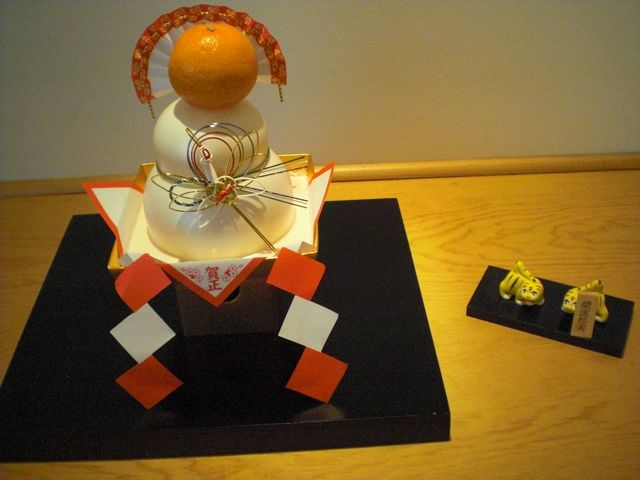
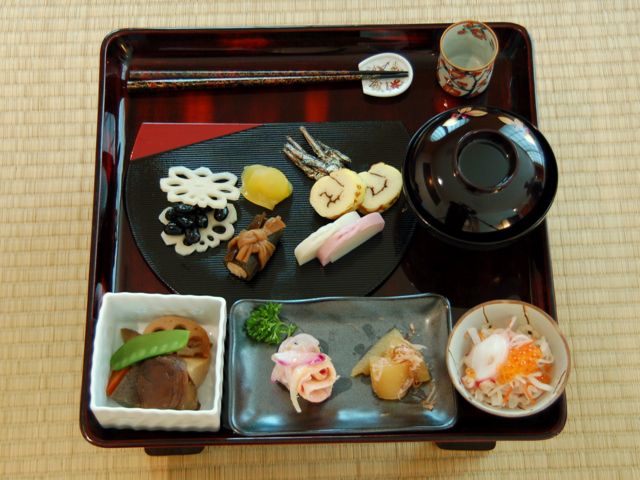
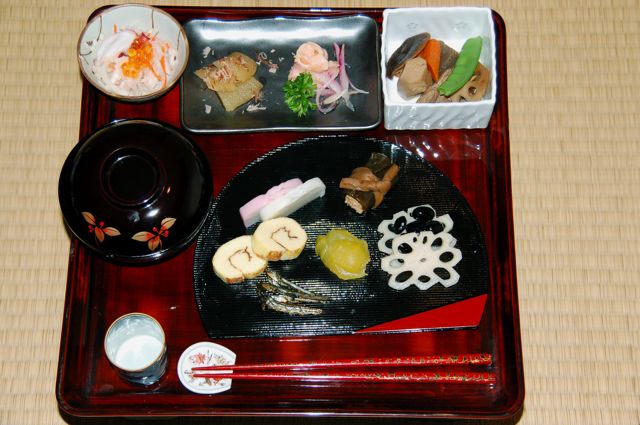
New Year Soup お雑煮
Only unusual thing I do is to put "mochi" 餅 or rice cake in " fried tofu pouch "aburage" 油揚 as per my wife's request. So that the sticky mochi will not dissolve or attached to your teeth and the bowl. In addition to keeping the mochi under control, the combination tastes pretty good.

Assorted appetizers "Kuchitori" お口取り
Small fish ごまめ, red and white fish cakes 紅白かまぼこ, sweet chestnut 栗きんとん and black beans 黒豆 are bought ready made. The rest were home made. Rolled omelet 伊達巻きwas made from eggs and commercial "hanpen" はんぺん a type of white fish cake, lotus root or renkon レンコン was bought already cleaned and boiled but then I made this "flower" cut and vinegared it. For the first time, I also made kelp roll with salmon 鮭の昆布巻き, which, if I say so myself and my wife (who is impartial) also agrees that this was much much better than the commercial product.

Vegetable and chicken stew 筑前煮
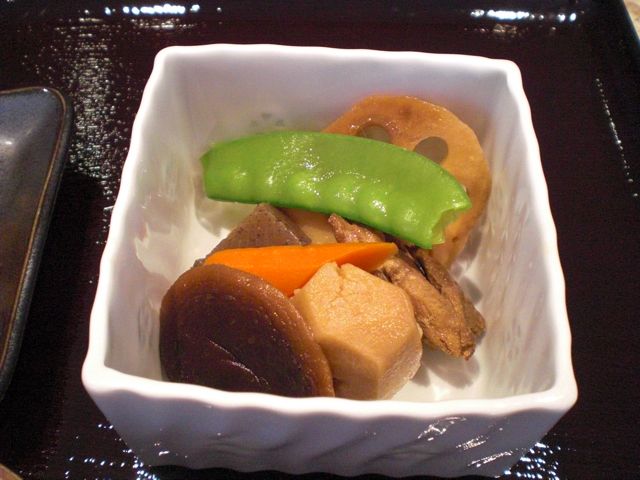
Marinated salmon 鮭のロシア漬け、Herring roe 数の子
This salmon dish is my mother's recipe. She does not remember where she got it. Thinly sliced salmon was layered with onion, lemon slices and marinated in a mixture of sake, rice vinegar and olive oil for at least 3 days. The herring roe was first soaked in weak salt water to remove salt (they are sold preserved by heavily salting) and then marinated in dashi, mirin, and soy sauce mixture for a few days.
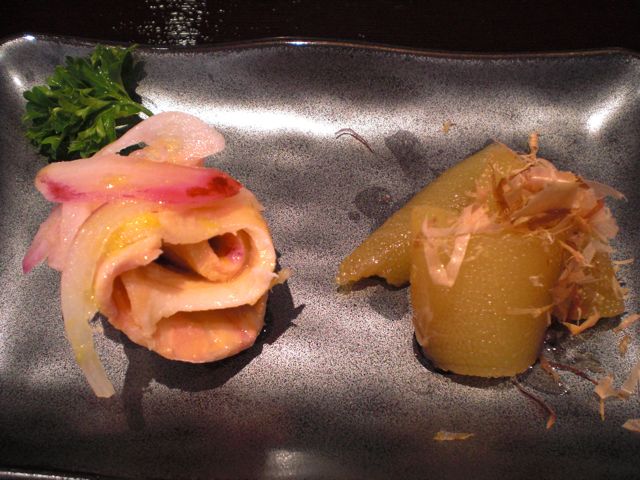
Julienned Daikon "Namasu" in sweet vinegar 大根なます, vinegard octopus 酢蛸,
Salmon roe いくら
For "Namasu", as per my mother's recipe, I do not add water or dashi and we like more assertive vinegar taste. The octopus was bought boiled and frozen and then sliced and vinegared before serving.
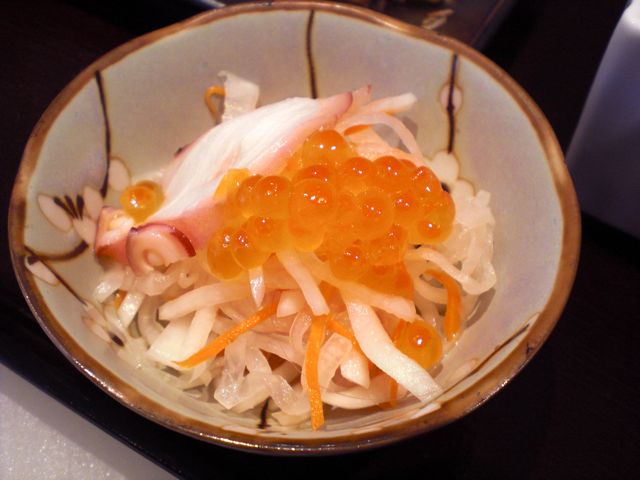
Chicken patty with pine nuts and miso 鶏肉野松風焼き, Scotch egg スコッチエッグ
I used boiled quail eggs rather than hens eggs for my Scotch eggs.
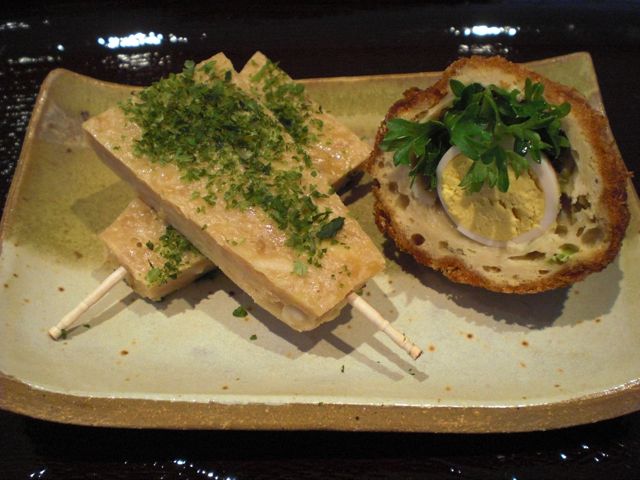
Only unusual thing I do is to put "mochi" 餅 or rice cake in " fried tofu pouch "aburage" 油揚 as per my wife's request. So that the sticky mochi will not dissolve or attached to your teeth and the bowl. In addition to keeping the mochi under control, the combination tastes pretty good.
Assorted appetizers "Kuchitori" お口取り
Small fish ごまめ, red and white fish cakes 紅白かまぼこ, sweet chestnut 栗きんとん and black beans 黒豆 are bought ready made. The rest were home made. Rolled omelet 伊達巻きwas made from eggs and commercial "hanpen" はんぺん a type of white fish cake, lotus root or renkon レンコン was bought already cleaned and boiled but then I made this "flower" cut and vinegared it. For the first time, I also made kelp roll with salmon 鮭の昆布巻き, which, if I say so myself and my wife (who is impartial) also agrees that this was much much better than the commercial product.
Vegetable and chicken stew 筑前煮
Marinated salmon 鮭のロシア漬け、Herring roe 数の子
This salmon dish is my mother's recipe. She does not remember where she got it. Thinly sliced salmon was layered with onion, lemon slices and marinated in a mixture of sake, rice vinegar and olive oil for at least 3 days. The herring roe was first soaked in weak salt water to remove salt (they are sold preserved by heavily salting) and then marinated in dashi, mirin, and soy sauce mixture for a few days.
Julienned Daikon "Namasu" in sweet vinegar 大根なます, vinegard octopus 酢蛸,
Salmon roe いくら
For "Namasu", as per my mother's recipe, I do not add water or dashi and we like more assertive vinegar taste. The octopus was bought boiled and frozen and then sliced and vinegared before serving.
Chicken patty with pine nuts and miso 鶏肉野松風焼き, Scotch egg スコッチエッグ
I used boiled quail eggs rather than hens eggs for my Scotch eggs.
Subscribe to:
Posts (Atom)

